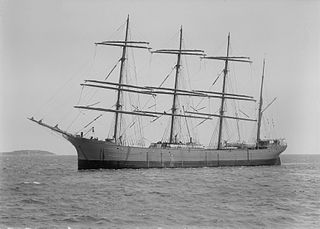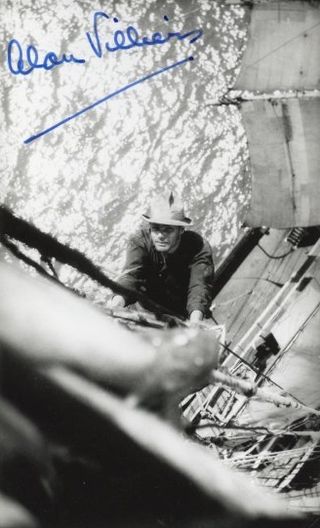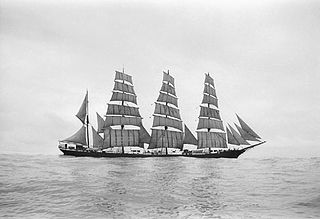
A ship is a large watercraft that travels the world's oceans and other sufficiently deep waterways, carrying cargo or passengers, or in support of specialized missions, such as defense, research and fishing. Ships are generally distinguished from boats, based on size, shape, load capacity and purpose. Ships have supported exploration, trade, warfare, migration, colonization, and science. After the 15th century, new crops that had come from and to the Americas via the European seafarers significantly contributed to world population growth. Ship transport is responsible for the largest portion of world commerce.

A sailing ship is a sea-going vessel that uses sails mounted on masts to harness the power of wind and propel the vessel. There is a variety of sail plans that propel sailing ships, employing square-rigged or fore-and-aft sails. Some ships carry square sails on each mast—the brig and full-rigged ship, said to be "ship-rigged" when there are three or more masts. Others carry only fore-and-aft sails on each mast, for instance some schooners. Still others employ a combination of square and fore-and-aft sails, including the barque, barquentine, and brigantine.

Star of India is an iron-hulled sailing ship, built in 1863 in Ramsey, Isle of Man as the full-rigged ship Euterpe. After a career sailing from Great Britain to India and New Zealand, she was renamed, re-rigged as a barque, and became a salmon hauler on the Alaska to California route. Retired in 1926, she was restored as a seaworthy museum ship in 1962–3 and home-ported at the Maritime Museum of San Diego in San Diego, California. She is the oldest ship still sailing regularly and also the oldest iron-hulled merchant ship still afloat. The ship is both a California Historical Landmark and United States National Historic Landmark.

A barque, barc, or bark is a type of sailing vessel with three or more masts and mainmasts rigged square and only the mizzen rigged fore and aft. Sometimes, the mizzen is only partly fore-and-aft rigged, bearing a square-rigged sail above.

The RRS Discovery is a barque-rigged auxiliary steamship built in Dundee, Scotland for Antarctic research. Launched in 1901, she was the last traditional wooden three-masted ship to be built in the United Kingdom. Her first mission was the British National Antarctic Expedition, carrying Robert Falcon Scott and Ernest Shackleton on their first, and highly successful, journey to the Antarctic, known as the Discovery Expedition.

Falls of Clyde is the last surviving iron-hulled, four-masted full-rigged ship, and the only remaining sail-driven oil tanker. Designated a U.S. National Historic Landmark in 1989, she is now a museum ship in Honolulu, but her condition has deteriorated. She is currently not open to the public. In September 2008, ownership was transferred to a new nonprofit organization, the Friends of Falls of Clyde. Efforts to raise $1.5 million to get the ship into drydock did not succeed. In November 2021 HDOT accepted a bid from Save Falls of Clyde – International (FOCI) to transport the ship to Scotland for restoration.

Lawhill was a steel-hulled four-masted barque rigged in "jubilee" or "baldheaded" fashion, i.e. without royal sails over the top-gallant sails, active in the early part of the 20th century. Although her career was not especially remarkable, save perhaps for being consistently profitable as a cargo carrier, in the 1930s Richard Cookson went on board and extensively documented Lawhill's internals and construction, which was later published in the Anatomy of the Ship series.

Iron-hulled sailing ships represented the final evolution of sailing ships at the end of the age of sail. They were built to carry bulk cargo for long distances in the nineteenth and early twentieth centuries. They were the largest of merchant sailing ships, with three to five masts and square sails, as well as other sail plans. They carried lumber, guano, grain or ore between continents. Later examples had steel hulls. They are sometimes referred to as "windjammers" or "tall ships". Several survive, variously operating as school ships, museum ships, restaurant ships, and cruise ships.

Polly Woodside is a Belfast-built, three-masted, iron-hulled barque, preserved in Melbourne, Victoria (Australia), and forming the central feature of the South Wharf precinct. The ship was originally built in Belfast by William J. Woodside and was launched in 1885. Polly Woodside is typical of thousands of smaller iron barques built in the last days of sail, intended for deep water trade around the world and designed to be operated as economically as possible.

Peking is a steel-hulled four-masted barque. A so-called Flying P-Liner of the German company F. Laeisz, it was one of the last generation of cargo-carrying iron-hulled sailing ships used in the nitrate trade and wheat trade around Cape Horn.

Alan John Villiers, DSC was a writer, adventurer, photographer and mariner.

A jackass-barque, sometimes spelled jackass bark, is a sailing ship with three masts, of which the foremast is square-rigged and the main is partially square-rigged and partially fore-and-aft rigged (course). The mizzen mast is fore-and-aft rigged.

Potosi was a five-masted steel barque built in 1895 by Joh. C. Tecklenborg ship yard in Geestemünde, Germany, for the sailing ship company F. Laeisz as a trading vessel. Its primary purpose was as a "nitrate clipper" collecting guano in South America for use in chemical companies in Germany. As its shipping route was between Germany and Chile, it was designed to be capable of withstanding the rough weather encountered around Cape Horn.

Gustaf Adolf Mauritz Erikson was a ship-owner from Mariehamn, in the Åland islands. He was famous for the fleet of windjammers he operated to the end of his life, mainly on the grain trade from Australia to Europe.
Hamburg was a three masted barque built in 1886 at Hantsport, Nova Scotia. She was the largest three masted barque ever built in Canada.

Parma was a four-masted steel-hulled barque which was built in 1902 as Arrow for the Anglo-American Oil Co Ltd, London. In 1912 she was sold to F. Laeisz, Hamburg, Germany. During the First World War she was interned in Chile, and postwar was assigned to the United Kingdom as war reparations. She was sold back to Laiesz in 1921. She was sold in 1931 to Ruben De Cloux & Alan Villiers of Mariehamn, Finland. Following an accident in 1936, she was sold and hulked at Haifa, British Mandate of Palestine, now Israel, for two years before being scrapped.

Carthaginian was a three-masted barque outfitted as a whaler that served both as a movie prop and a museum ship in Hawaii. Laid down and launched in Denmark in 1921 as the three-masted schooner Wandia, she was converted in 1964–1965 into a typical square-rigged 19th-century whaler for the filming of the 1966 movie Hawaii. Afterward, she was moored in the harbor of the former whaling port-of-call of Lāhainā on the Hawaiian island of Maui, explaining the whaling industry in the Hawaiian islands. Carthaginian was lost in 1972 when she ran aground just outside the harbor on its way to drydock maintenance on Oahu and was replaced as a whaling museum by Carthaginian II in 1980.

The Falls Line was a Scottish shipping line in the late 19th and early 20th centuries. The line operated ships of two companies; Wright, Breakenridge & Co. and Wright and Graham & Co.. Both companies' ships used the same flag. The Falls Line does not appear to have operated ships after 1914, although some of the company's ships continued in operation for other owners.

Birkdale, a steel, steam-powered barque, is best known for being the inspiration behind many paintings by John Everett. Everett joined the barque Birkdale in 1920 and on a short voyage drew and painted many drawings and paintings, most of which are hung in the National Maritime Museum at Greenwich. She was the last barque to fly the red ensign, and she spent almost all her working life carrying nitrate from Chile. In June 1927, Birkdale ran aground and wrecked after catching fire in the Nelson Strait while en route to Peru.

Mabel Young was an iron barque built in 1877 by Alexander Stephen & Sons, Glasgow, as Yard No. 215. Dimensions: 211'0"×33'6"×20'45 and tonnage: 1046 GRT, 1015 NRT. Rigged with royals, over single topgallant and double topsails.



















